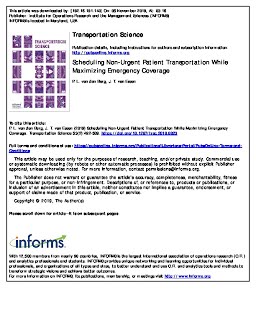2019-03-01
Scheduling non-urgent patient transportation while maximizing emergency coverage
Publication
Publication
Transportation Science , Volume 53 - Issue 2 p. 492- 509
Many ambulance providers operate both advanced life support (ALS) and basic life support (BLS) ambulances. Typically, only an ALS ambulance can respond to an emergency call, whereas non-urgent patient transportation requests can be served by either an ALS or a BLS ambulance. The total capacity of BLS ambulances is usually not enough to fulfill all non-urgent transportation requests. The remaining transportation requests then have to be performed by ALS ambulances, which reduces the coverage for emergency calls. We present a model that determines the routes for BLS ambulances while maximizing the remaining coverage by ALS ambulances. Different from the classical dial-a-ride problem, only one patient can be transported at a time, and not all requests are known in advance. Throughout the day, new requests arrive, and we present an online model to deal with these requests.
| Additional Metadata | |
|---|---|
| , , , | |
| doi.org/10.1287/trsc.2018.0823 | |
| Transportation Science | |
| From Reactive to Proactive Planning of Ambulance Planning Services | |
| Organisation | Centrum Wiskunde & Informatica, Amsterdam (CWI), The Netherlands |
|
van den Berg, P., & van Essen, T. (2019). Scheduling non-urgent patient transportation while maximizing emergency coverage. Transportation Science, 53(2), 492–509. doi:10.1287/trsc.2018.0823 |
|

